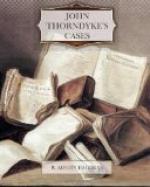“I think I see the police inspector on the platform,” remarked Thorndyke, as we approached the station.
“Yes, there he is,” said our guide. “Come down to see what you are after, sir, I expect.” Which was doubtless the case, although the officer professed to be there by the merest chance.
“You would like to see the weapon, sir, I suppose?” he remarked, when he had introduced himself.
“The umbrella-spike,” Thorndyke corrected. “Yes, if I may. We are going to the mortuary now.”
“Then you’ll pass the station on the way; so, if you care to look in, I will walk up with you.”
This proposition being agreed to, we all proceeded to the police-station, including the station-master, who was on the very tiptoe of curiosity.
“There you are, sir,” said the inspector, unlocking his office, and ushering us in. “Don’t say we haven’t given every facility to the defence. There are all the effects of the accused, including the very weapon the deed was done with.”
“Come, come,” protested Thorndyke; “we mustn’t be premature.” He took the stout ash staff from the officer, and, having examined the formidable spike through a lens, drew from his pocket a steel calliper-gauge, with which he carefully measured the diameter of the spike, and the staff to which it was fixed. “And now,” he said, when he had made a note of the measurements in his book, “we will look at the colour-box and the sketch. Ha! a very orderly man, your brother. Mr. Stopford. Tubes all in their places, palette-knives wiped clean, palette cleaned off and rubbed bright, brushes wiped—they ought to be washed before they stiffen—all this is very significant.” He unstrapped the sketch from the blank canvas to which it was pinned, and, standing it on a chair in a good light, stepped back to look at it.
“And you tell me that that is only three hours’ work!” he exclaimed, looking at the lawyer. “It is really a marvellous achievement.”
“My brother is a very rapid worker,” replied Stopford dejectedly.
“Yes, but this is not only amazingly rapid; it is in his very happiest vein—full of spirit and feeling. But we mustn’t stay to look at it longer.” He replaced the canvas on its pins, and having glanced at the locket and some other articles that lay in a drawer, thanked the inspector for his courtesy and withdrew.
“That sketch and the colour-box appear very suggestive to me,” he remarked, as we walked up the street.
“To me also,” said Stopford gloomily, “for they are under lock and key, like their owner, poor old fellow.”
He sighed heavily, and we walked on in silence.
The mortuary-keeper had evidently heard of our arrival, for he was waiting at the door with the key in his hand, and, on being shown the coroner’s order, unlocked the door, and we entered together; but, after a momentary glance at the ghostly, shrouded figure lying upon the slate table, Stopford turned pale and retreated, saying that he would wait for us outside with the mortuary-keeper.




